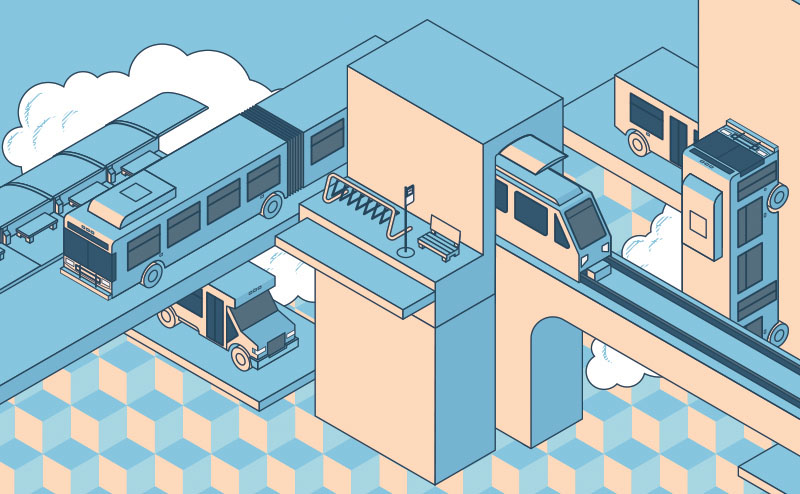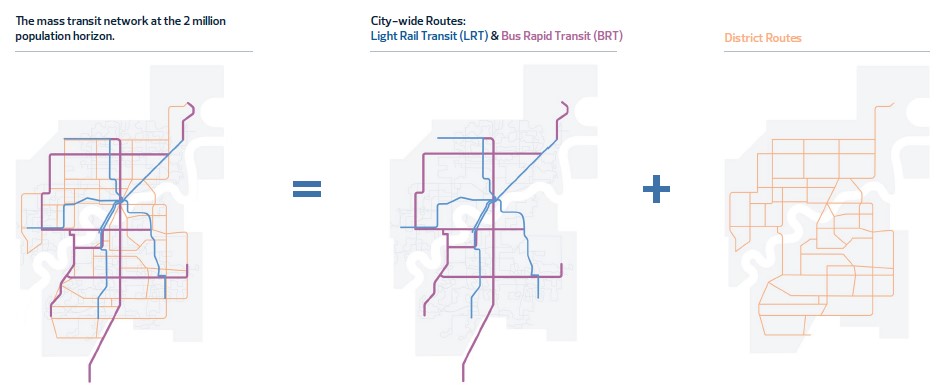Edmonton’s existing mass transit network is expanding to include not just LRT but also new, bus-based mass transit routes.
When these projects are combined with the existing local transit service, this will create an integrated transit system.
Main page content begins here

Investing in a robust, seamless transit network, with mass transit serving as the backbone, is critical to achieving The City Plan goal of an urban, climate resilient city of 2 million people.
Mass transit is critical to connecting people with the places that matter to them. It is one of the most efficient ways to move large groups of people across the city between significant urban centres and main streets, which are known in The City Plan as nodes and corridors. An evolved mass transit system that supports our nodes and corridors is the central backbone of a successful transit network.
Learn more about mass transit and the integrated transit network .
Edmonton’s existing mass transit network is expanding to include not just LRT but also new, bus-based mass transit routes.
When these projects are combined with the existing local transit service, this will create an integrated transit system.

City-wide routes provide the foundation of public transit and create a mass transit network that connects all corners of the city. They provide high-speed travel between urban nodes and main corridors, with only key stops along the way. The transit service runs along roads where infrastructure prioritizes transit travel, such as train tracks or dedicated bus lanes.
The 2 main types of city-wide mass transit routes being implemented in Edmonton are:
Light Rail Transit (LRT) (blue route lines) is a style of urban rail-based passenger services which can provide high capacity and speed, but typically travel slower and use smaller vehicles than long-distance rail services. In Edmonton, LRT includes High Floor LRT (Capital and Metro Lines) and Low Floor LRT (Valley Line).
Bus Rapid Transit (BRT) (magenta route lines) would get a similar level of service to the LRT by giving the buses their own dedicated lanes for at least 75% of the route and priority at intersections. These routes will be served by stations and enhanced stops. Bus Rapid Transit routes represent a new tool in the transit “toolbox”. Work to establish how the routes will look and operate is being done as part of bus-based mass transit planning for 1.25 million people.
District Bus-Based Routes (yellow route lines) supplement and fill in the gaps of the city-wide (LRT and BRT) routes to complete the mass transit network. They have priority at intersections to provide efficient and reliable travel within and between clusters of neighbourhoods (known in The City Plan as districts). District routes also connect and feed into cross-city transit routes, extending the reach of the mass transit and transit network in Edmonton.
There are 2 types of district bus route service:
Rapid Limited-Stop Node Service bus routes run within and between districts, connecting people to key urban centres (nodes). These routes travel faster than frequent or local routes by only stopping at strategic locations along the way and bypassing intermediate stops. These routes may include higher capacity buses and some transit priority measures, such as transit signal priority at intersections and queue jumps. Service on these routes would function similarly to current rapid or express-type bus routes.
Frequent Enhanced Corridor Service bus routes run along corridors (for example: Jasper Avenue, 124 Street) and run with short headways (many buses serve the route), resulting in reduced wait times. Stops tend to be spaced closely together to reduce walking distance and make transfers more practical. Because frequent routes stop often, they tend to be slower than the rapid routes but can still move a lot of people along main streets and other busy corridors. Service on these routes would function somewhat similarly to current regular bus service along a main street, except wait times would be shorter due to shorter headways.
Regional Routes will be integral to the continued prosperity and connectivity of the Edmonton region. These routes will be guided by regional partners and entities.
Regional Connectors (not shown) operate partly or entirely outside of Edmonton. Most regional connections operate as rapid transit routes between municipalities in the Edmonton Metropolitan Region like St. Albert, Sherwood Park and others.
Airport Connector is currently planned to be a Bus Rapid Transit (BRT) connection between Downtown and the Edmonton International Airport with some intermediate stations. It does not consist of an extension of the LRT past city boundaries.
The City Plan - Edmonton’s combined Municipal Development Plan and Transportation Master Plan- envisions a city of 2 million people where Edmontonians of all ages, abilities and backgrounds can easily meet their daily needs within a short walk, bike, roll and/or transit trip. To achieve this, we’ll need to transform our mobility system to prioritize a broader array of interconnected travel options anchored by a robust transit system so people have more choice in how they move around.
A well-integrated transit network, with mass transit serving as the backbone, will provide Edmontonians with access to safe, convenient and reliable service with faster travel times. Not only does expanding mass transit provide people with more convenient travel options; it also helps us reach our climate resiliency goals.
Having more mass transit options will contribute to reaching The City Plan target of 50% of all trips being made by transit or active transportation. This reduces our environmental footprint by helping to reduce the number of trips taken by personal vehicles, which will have a positive impact on managing congestion and greenhouse gas emissions.
A robust mass transit network also supports regional and economic prosperity by effectively linking workers and customers with businesses. It also helps us build a more welcoming and inclusive city by removing travel barriers and providing people with more diverse, convenient and affordable options to get around.
Four success factors are key to supporting the mass transit network.
Converting vehicle lanes to dedicated transit lanes represents a significant shift in our approach that will help to increase transit capacity, improve reliability, reduce travel times, and provide opportunities for service to respond to ridership growth. Ultimately, faster and more frequent service will result in ridership gains as transit service better competes with travel by personal vehicles.
Mass transit succeeds when paired with supportive land uses like higher-density residential and commercial developments, particularly in priority growth areas. This further highlights the role of The City Plan and how the nodes and corridors approach is a key part of our transportation planning.
There is an opportunity to provide mass transit service and infrastructure to supplement the LRT by way of bus-based mass transit. Bus-based mass transit will allow higher orders of transit service to reach more areas of the city and can provide additional capacity to the LRT where needed.
Parking pricing and availability, including park and ride and the development of mobility hubs, will allow people to connect to the mass transit network by local transit, car, bike, walking or rolling.